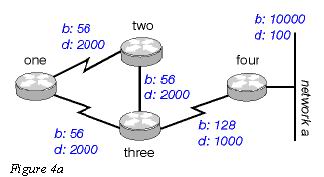Which two statements are correct about routing tables in JUNOS?()A、There are separate tables for IPv4 and IPv6 called inet.0 and inet6.0 respectively.B、They only contain the best possible route to each destination.C、All running protocols can populate the
题目
Which two statements are correct about routing tables in JUNOS?()
- A、There are separate tables for IPv4 and IPv6 called inet.0 and inet6.0 respectively.
- B、They only contain the best possible route to each destination.
- C、All running protocols can populate the routing tables at the same time.
- D、Routes with the highest preference value are placed as active routes in the routing table.
相似问题和答案
第1题:
A.There are separate tables for IPv4 and IPv6 called inet.0 and inet6.0 respectively.
B.They only contain the best possible route to each destination.
C.All running protocols can populate the routing tables at the same time.
D.Routes with the highest preference value are placed as active routes in the routing table.
第2题:
Split horizon has been enabled within the Ezonexam routed network. Which one of the following statements best explains the split horizon rule?
A.Only routers can split boundaries (horizons) between networks in separate AS numbers.
B.Each AS must keep routing tables converged to prevent dead routes from being advertised across boundaries.
C.Once a route is received on an interface, advertise that route as unreachable back out the same interface.
D.Information about a route should never be sent back in the direction from which the original update came.
E.None of the above
解析:Explanation:
The split horizon rule states:
* Never advertise a route out of the interface through which you learned it.
For instance, in Figure 4a below, if Router One is connected to Routers Two and Three through a single multipoint interface (such as Frame. Relay), and Router One learned about Network A from Router Two, it will not advertise the route to Network A back out the same interface to Router Three. Router one assumes that Router Three would learn about Network A directly from Router Two.

Incorrect Answers:
A: There is no such requirement
B: Distance vector protocols updates routing table at regular intervals instead of Topology changes
C: This is the definition of the poison reverse rule, not the split horizon rule.
第3题:
A. Firewall filters are stateless.
B. Firewall filters are used to control routing information that is exchanged between devices.
C. Firewall filters are used to control traffic passing through the device.
D. Firewall filters can only be applied to traffic entering the device.
第4题:
Which one of the following statements best explains the split horizon rule?()
- A、Only routers can split boundaries (horizons) between networks in separate AS numbers.
- B、Each AS must keep routing tables converged to prevent dead routes from being advertised across boundaries.
- C、Once a route is received on an interface, advertise that route as unreachable back out the same interface.
- D、Information about a route should never be sent back in the direction from which the original update came.
正确答案:D
第5题:
A. The exchange of an advertisement is triggered by a change in the network.
B. All routers exchange routing tables with each other in a multipoint network.
C. Packets are routed based upon the shortest path to the destination.
D. Paths are chosen depending on the cost efficiency factor.
E. Every router in an OSPF area is capable of representing the entire network topology.
F. Only the designated router in an OSPF area can represent the entire network topology.
第6题:
A.The Routing Engine handles all exception traffic.
B.The Routing Engine synchronizes the route table with the PFE
C.The Routing Engine is hot-pluggable.
D.The Routing Engine controls the PFE
第7题:
A. Only routers can split boundaries (horizons) between concentric networks.
B. Each AS must keep routing tables converged to prevent dead routes from being advertised across boundaries.
C. Networks can only remain fully converged if all information is sent out all active interfaces.
D. Information about a route should not be sent back in the direction from which the original update came.
E. Distance vector protocols need fall back routers that are responsible for momentary loops.
第8题:
A. The routing table is populated by the forwarding table.
B. Devices running the Junos OS can accommodate multiple routing tables.
C. Information learned from routing protocols is stored in the routing table.
D. The primary routing table for IPv4 unicast routes is inet.4.
第9题:
A. Only router can split boundaries(horizons)between concentric networks.
B. All distance vector protocols require fall routes that may cause momentary loops as the topology changes.
C. Networks can only remain fully converged if all information about routes is sent out all active interfaces.
D. Information about a route should not be sent back in the direction from which the original update came.
E. Each AS must keep routing tables converged to prevent dead routes from being advertised across the AS boundary.
第10题:
Which statement is true regarding the Junos OS?()
- A、All platforms running the Junos OS separate the functions of learning and flooding.
- B、All platforms running the Junos OS separate the functions of control and forwarding.
- C、All platforms running the Junos OS separate the functions of routing and bridging.
- D、All platforms running the Junos OS separate the functions of management and routing.
正确答案:B
